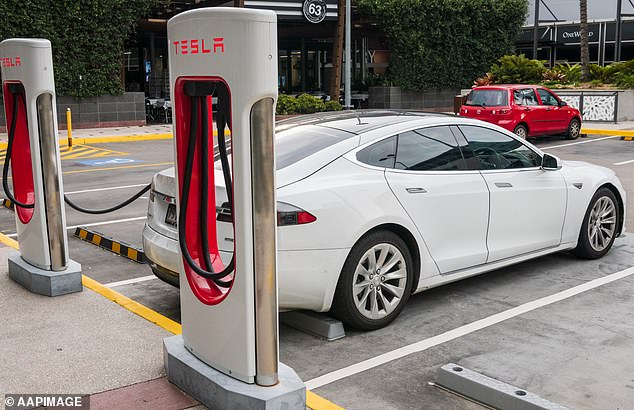Single picture of queuing Teslas perfectly illustrates the problem Australia will face ditching petrol cars
A single photo of Tesla cars queuing at a charging station over Easter weekend shows the problem Australians could face if the government decides to ditch petrol cars.
In the rural town of Keith, South Australia, at least ten electric vehicles were lined up, with drivers waiting to use public charging stations.
One TikTok user shared a video of the cars lined up with the caption: “Buy a Tesla, they said.”
At least ten electric vehicles were lined up in the rural town of Keith, South Australia, with drivers waiting to use public charging stations
Bernhard Conoplia, head of public charging at charging company Evie, explains Yahoo News the charging stations would have been up to four times busier during the long weekend than during a normal weekend.
She said simple steps like leaving home with a full battery would go a long way, but it seems these Tesla owners have learned the hard way.
A Tesla Model 3 sedan takes at least 20 minutes to fully charge at a Supercharger station, meaning some owners may have waited hours before getting back on the road.
There are approximately 198,000 electric vehicles on Australian roads, but there are currently only 3,000 public charging stations nationwide.
The government claims it is working quickly to increase the availability of fast chargers, with the number of locations expected to double this year.

There are approximately 198,000 electric vehicles on Australian roads, but there are currently only 3,000 public charging stations nationwide
A report from consultancy Next System also found that while Tesla dominated electric vehicle sales, Chargefox provided the largest share of charging locations.
The findings came after record sales of electric vehicles and despite concerns from some potential buyers that Australia’s charging network was not large enough to support the technology.
The Public Fast Charger Network Report shows that an additional 397 car charging stations and 755 new charging points will be built in Australia by 2023, but predicts this number will rise significantly higher by 2024.
Next System founder Daniel Bleakley said the analysis showed charging stations were already planned for a further 470 locations across Australia and a total of 900 new charging locations could be expected over the year.
“After a slow start, the growth of Australia’s public EV fast charging network is clearly accelerating,” Bleakley said.
“The lack of public fast-charging infrastructure is often cited as a major barrier to the uptake of electric vehicles in Australia, but our report shows that the EV charging network is now actually growing faster than the Australian EV fleet.”
The report found that local company Chargefox had installed the largest number of electric chargers in Australia, operating more than one in three charging locations, followed by Evie Networks with 23 percent of the market and Tesla with 10 percent.
Jolt and NRMA followed in fourth and fifth places, while electric car charging stations from traditional petrol retailers BP and Ampol claimed sixth and seventh positions as their national rollout increased.
However, US carmaker Tesla offered the most power through its electric chargers, with its Supercharger network representing almost half the capacity of Australia’s charging network, according to the report.
The findings come after Australians bought more than 87,000 electric cars in 2023, according to the Federal Chamber of Automotive Industries, representing more than seven per cent of all new vehicles and more than double the number sold in 2022.
According to a Pureprofile survey of more than 2,000 Australians late last year, the availability of public charging stations was one of the biggest concerns for motorists unsure about buying an electric vehicle, after the purchase price.
Electric vehicles are a crucial part of the government’s strategy to reduce emissions from new vehicles by 61 percent by 2030.
The NSW Government is investing almost half a billion dollars over the next four years in tax cuts and incentives to boost uptake and reduce barriers to purchasing electric vehicles.
